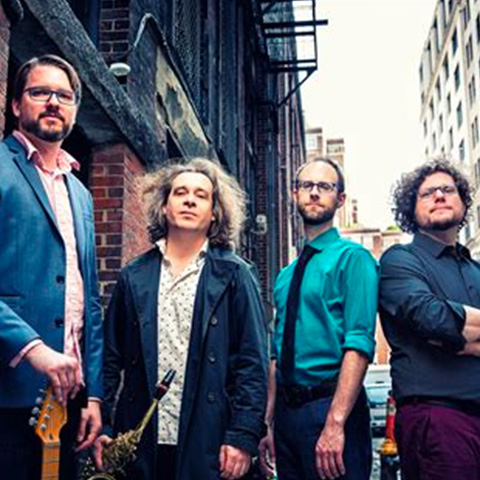Hinge Quartet: Ghost in the Machine
Please see the events listing for upcoming events.

Praised as “experimental and ethereal” and a “welcome addition to the new music scene,” the Hinge Quartet is made up of Philipp Stäudlin (saxophones), Dan VanHassel (electric guitar), Matt Sharrock (percussion), and Keith Kirchoff (piano). Lying somewhere between a chamber ensemble and an avant-garde rock band, the Hinge Quartet combines cutting-edge contemporary classical and experimental music with seamless multimedia integration and the innovative re-imagining of rock and pop songs.
Hinge Quartet presents Ghost in the Machine, featuring recent works exploring our search for humanity and connection in a chaotic and technology-driven world. Hinge pianist Keith Kirchoff’s beautiful and evocative “Emergence” opens the program with an artistic response to emerging from the isolation of the pandemic, while guitarist Dan VanHassel’s work “Ghost in the Machine” explores humanity’s relationship with technology through the use of electronically triggered percussion instruments directly interacting with the ensemble. Next is the world premiere of the richly varied “No Rest for the Wicked” by Kirsten Volness, which she describes as “an effort to exorcize the demons, to shake them off, to dance them into another dimension.” Irish composer Donnacha Dennehey’s intensely rhythmic and thrilling “Glamour Sleeper II” is heard next, in a brand new arrangement for the group. Rounding out the program are two Boston premieres of two very different recent Hinge Quartet commissions by Wisconsin composer Ed Martin and Turkish composer and sound artist Eda Er. The Er piece is an introspective rumination on the fleeting nature of human connection, and the Martin is a blast of kinetic energy to bring things to a close.
Program Information
Boston Conservatory thanks audience members for viewing this program information online. This paperless program saved 200 sheets of paper, 21 gallons of water, and 18 pounds of CO2-equivalent greenhouse gas emissions.
